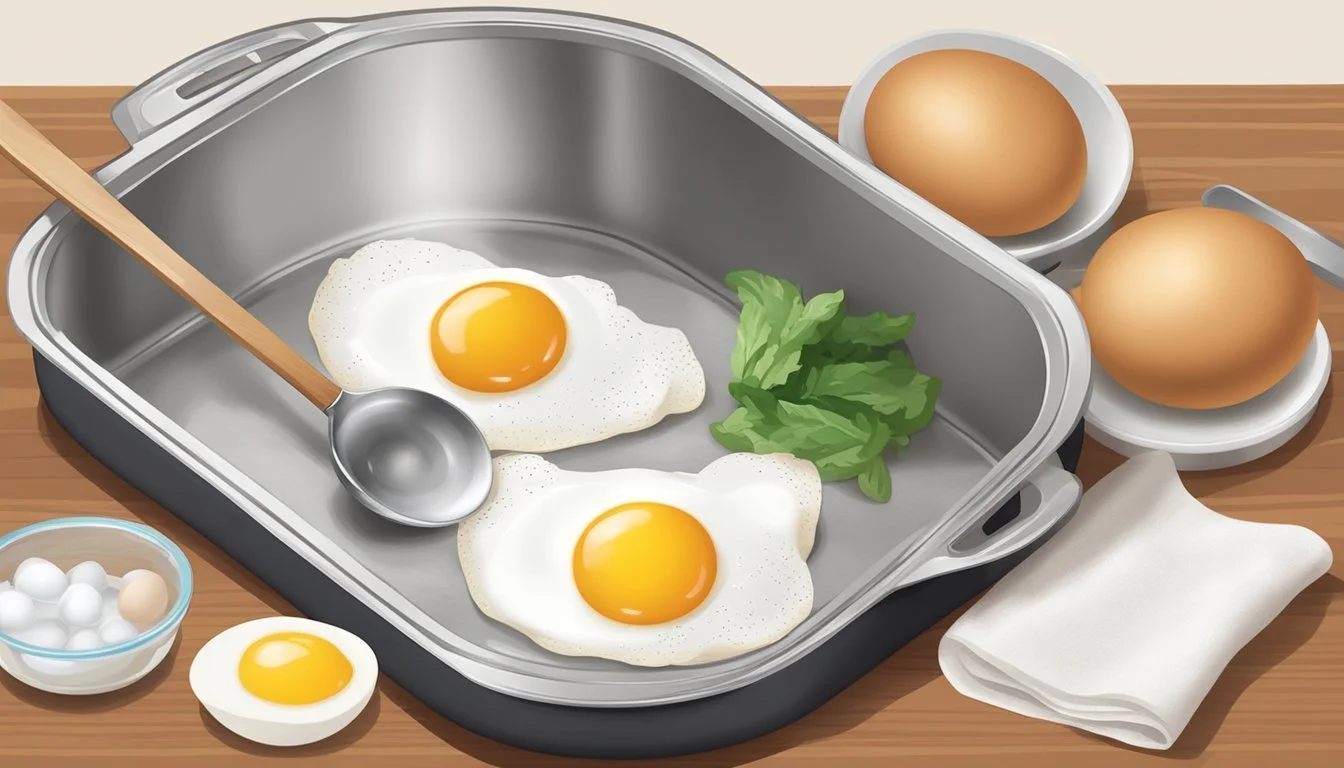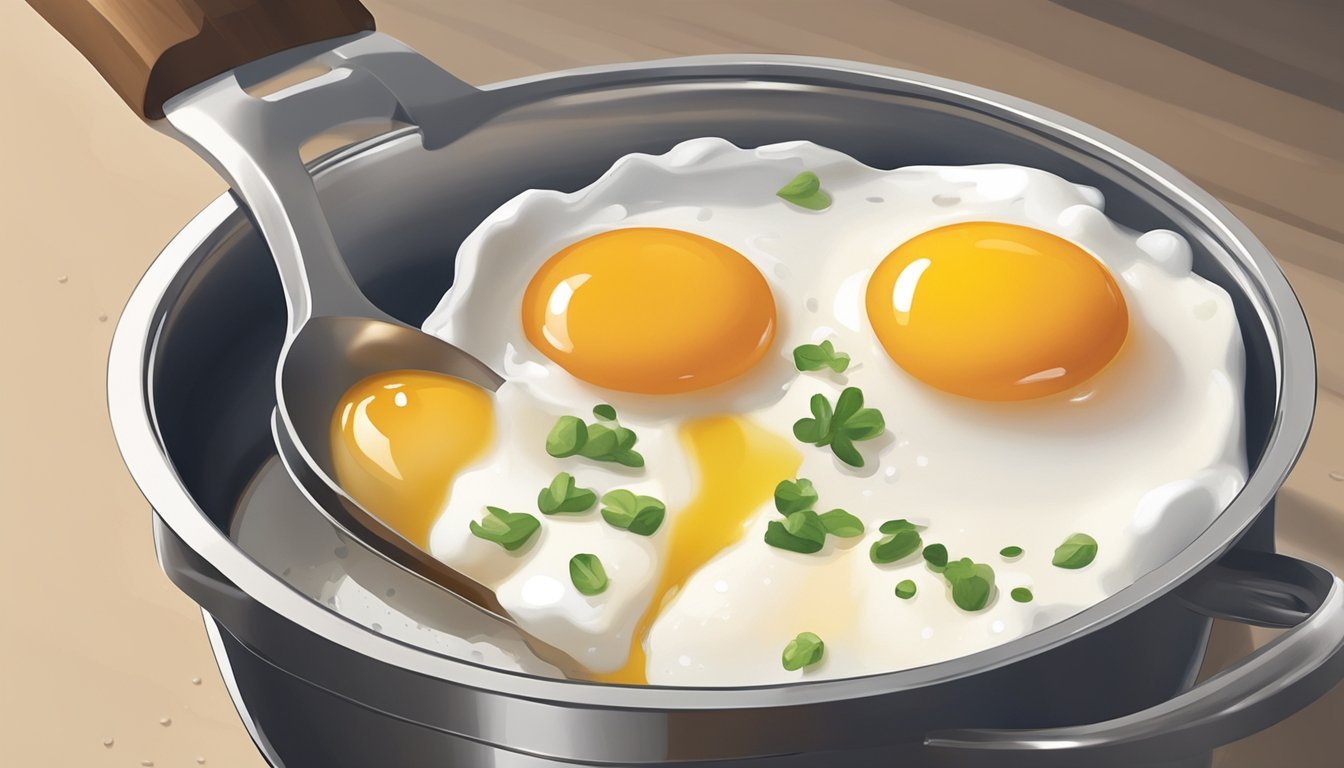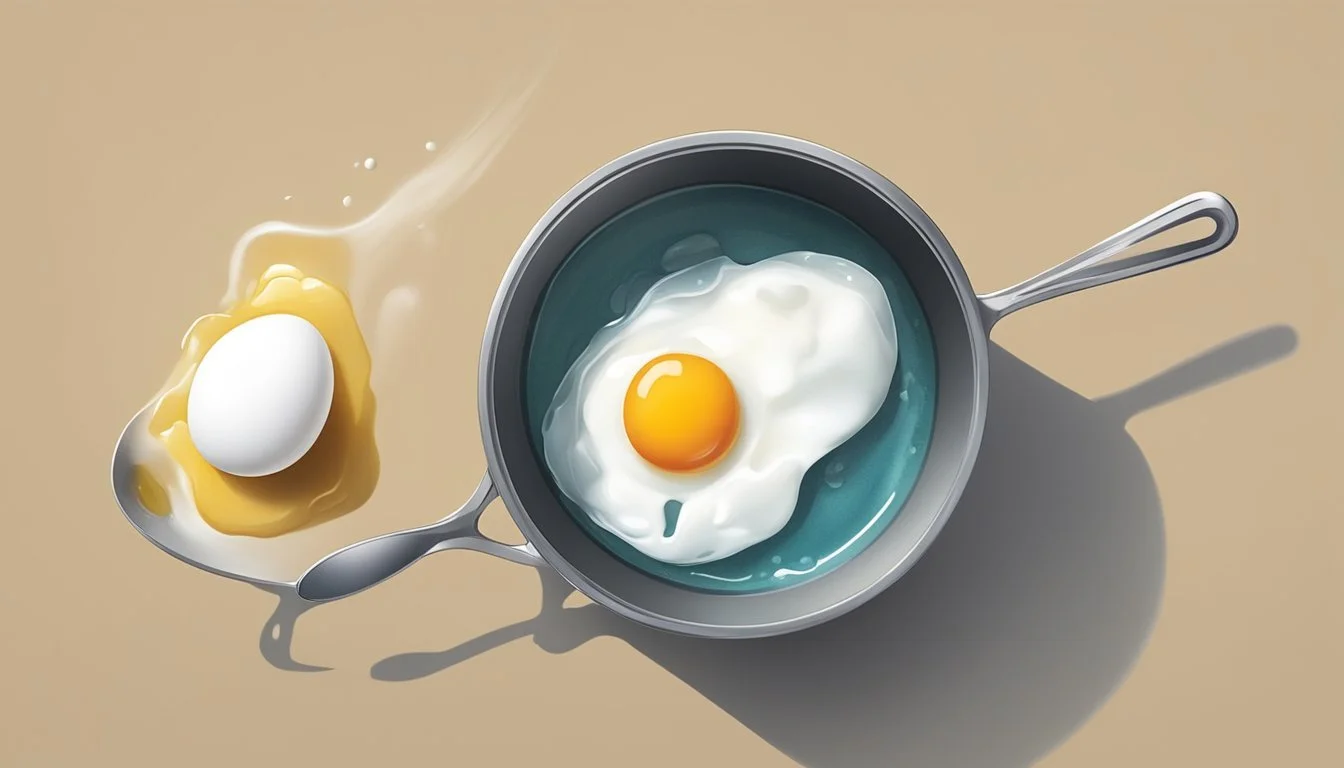Best Way to Reheat a Poached Egg for a Perfectly Runny Yolk Every Time
Poached eggs are a breakfast favorite known for their delicate whites and soft, runny yolks. Achieving the perfect poach is an art, but so is reheating them to that just-right temperature where they're warm but maintain the coveted runny center. Reheating poached eggs correctly ensures they retain their quality, and the method is straightforward once understood.
Many believe that reheating a poached egg without overcooking it is challenging, but by using the right technique, one can enjoy a deliciously runny yolk with ease. The secret lies in using gentle heat to wake up the egg's flavors without pushing it towards being overcooked. This entails reheating them in water that's hot but not boiling, ensuring the egg reaches the ideal serving temperature without further cooking the yolk.
The ideal reheating strategy involves a pot of water brought to a near boil and then reduced to a simmer. Poached eggs are then placed in the water for a brief period, sufficient enough to warm through. Careful handling and a precise timing of 30 to 45 seconds yields a poached egg that is evenly heated, with a yolk that's still soft and ready to burst.
Understanding Poached Eggs
Proper comprehension of poached eggs sets the foundation for achieving that ideal runny yolk and delicate texture. Attention to cooking technique and the inherent qualities of eggs contributes to the desired outcome.
Defining Poached Eggs
Poached eggs are a preparation of eggs that are cooked in simmering water without their shell. Fresh eggs are ideal for poaching as they tend to hold their shape better in water. A poached egg is distinguished by its smooth, rounded edges, a tender white, and a yolk that is warm and runny. The process does not use any fats for cooking, which can be a benefit to those seeking less caloric intake from oils or butter.
Benefits of Poached Eggs
Poached eggs provide several nutritional and culinary advantages. Firstly, they are a rich source of high-quality protein, essential for muscle repair and growth. The cooking method also preserves the integrity of the egg's flavor. Additionally, since poached eggs are cooked without oil or butter, they offer a lower calorie count than fried or sautéed eggs, making them a healthier choice. The texture and consistency of a perfectly poached egg—one with a liquid yolk encased in a silky white—are highly prized in gastronomy for their versatility and mouthfeel.
Essential Ingredients for Poaching Eggs
To achieve the perfect poached egg with a runny yolk, one must pay attention to the quality of essential ingredients and their preparation. The choice of eggs and water treatment are pivotal in the poaching process.
Choosing the Right Eggs
Freshness is paramount when selecting eggs for poaching. The fresher the egg, the tighter its whites will hold together in the water, resulting in a neater poached egg. Ideally, one should use eggs that are as fresh as possible, often indicated by a thick, viscous egg white that clings closely to the yolk.
Tips for assessing egg freshness:
Use the float test: Place eggs in a bowl of water. Fresh eggs sink to the bottom, while older eggs float due to the increased air cell size.
Look for a vibrant yolk and a tight white: when cracked open on a flat surface, which are signs of a fresh egg.
Water Quality and Additives
The water in which eggs are poached should be clean and free of any impurities that could affect the taste or consistency of the eggs. Some poachers prefer to add vinegar and salt to the water, which can serve distinct purposes:
Vinegar: A tablespoon of vinegar can help the egg whites coagulate more rapidly by lowering the pH of the water, thus helping the egg retain its shape. However, it should be used in moderation to avoid imparting a vinegary flavor to the eggs.
Salt: While some cooks prefer to add salt for flavor, it is generally not necessary for the poaching process itself, as it can potentially break down the egg white rather than help it set.
Water preparation:
Bring water to a gentle simmer: Just before it reaches boiling point, with tiny bubbles rising from the bottom of the pot.
Avoid a rolling boil: To prevent the egg whites from dispersing and becoming feathery.
Following these guidelines ensures the poached egg will have a delicate white surrounding a perfectly runny yolk.
Poaching Techniques
Mastering poached eggs requires a careful balance of technique and practice. Two popular methods, the Creating a Vortex Method and the Saucepan Simmering Method, offer different approaches to achieve that perfectly runny yolk.
Creating a Vortex Method
To poach an egg using the vortex method, a cook first needs a pot of water brought to a gentle simmer. He or she then creates a vortex in the pot by stirring the water in a circular motion. Once a whirlpool forms, the cook carefully drops the egg into the center of the vortex. This helps the egg white wrap around the yolk, potentially resulting in a tidier poached egg.
Saucepan Simmering Method
The saucepan simmering method is more straightforward but requires more finesse. A cook fills a saucepan with about 2-3 inches of water and heats it until it reaches a gentle simmer—small bubbles should appear without the water fully boiling. The egg is then cracked and gently placed into the water. This method allows the egg to cook evenly without the agitation of a vortex.
Storing Poached Eggs
Proper storage of poached eggs is crucial for maintaining their delicate texture and ensuring a runny yolk upon reheating. The following best practices help avoid overcooking and preserve the eggs in their optimal state.
Refrigeration Best Practices
Temperature: The fridge should be set to 40°F (4°C) or below for safe storage of poached eggs.
Container: Store the eggs in a tight-sealed container or a covered bowl of cold water to maintain freshness and prevent absorption of fridge odors.
Duration: Poached eggs can be refrigerated for up to 2 days. Beyond this period, quality begins to decline.
Preventing Overcooking
Cold Water Bath: Immediately after poaching, transfer the eggs to a cold water bath to halt the cooking process and to help solidify the whites, keeping the yolks runny.
Reheating: When reheating, never bring the water to a boil as this will firm up the yolk. Instead, gently warm the eggs in water that is barely simmering for just 30 to 45 seconds to prevent the eggs from becoming overcooked.
Reheating Poached Eggs to Runny Yolk Perfection
Reheating poached eggs requires careful attention to retain a runny yolk. Two reliable techniques are the hot water method for even warming and the microwave technique for a quick approach.
Using the Hot Water Method
To reheat poached eggs using the hot water method, one should bring a pot of water to a near-boil. The water should be simmering, which is indicated by small bubbles—this represents a temperature warm enough to heat the eggs without further cooking the yolks. One then lowers the poached eggs into the water using a slotted spoon.
Time in Water: Approximately 30-45 seconds.
Temperature: Gentle simmer.
The eggs are left to sit for just long enough to heat through, typically around 30 to 45 seconds, ensuring the yolk remains runny. It is imperative to remove the eggs with a slotted spoon promptly and to drain any excess water off the eggs.
Microwave Reheating Technique
When using a microwave to reheat poached eggs, place the egg on a microwave-safe plate or dish. To prevent the eggs from drying out, cover the dish lightly with a damp paper towel. This setup creates a steamy environment in the microwave.
Power Setting: 50% power.
Duration: 20 seconds.
Microwaving should be done at 50% power to ensure gentle reheating. The eggs should only be microwaved for short intervals, about 20 seconds, to avoid overcooking the delicate yolks. After the initial time, one should check the eggs’ warmth and repeat in 10-second bursts if necessary.
Seasoning and Serving
Once poached eggs are reheated to a delicate consistency with a runny yolk, proper seasoning and serving can elevate the dish. The choice of seasoning and the accompanying base can turn a simple egg into a culinary delight.
Adding Flavor with Seasoning
When it comes to seasoning reheated poached eggs, it's essential to strike a balance that complements the egg without overwhelming its natural taste. A pinch of salt and a crack of black pepper are staple additions that bring out the egg's flavors. To add more dimension, a light sprinkle of fresh herbs such as chives, parsley, or dill can be very effective. For those who enjoy a bit of spice, a dash of paprika or chili flakes can provide an agreeable heat that pairs well with the egg's creaminess.
Pairing with Foods
Poached eggs are incredibly versatile and pair well with a variety of foods. When considering what to serve with a reheated poached egg, it's important to think about balance and texture. Avocado toast is a popular and healthful option that provides a creamy base with a rich flavor profile that matches well with the egg. For a more traditional approach, serving on English muffins with ham or bacon and hollandaise sauce makes for a classic Eggs Benedict. Here's a simple suggested pairing:
Avocado Toast with Poached Egg: Whole-grain toast, mashed avocado, poached egg, sesame seeds, a drizzle of olive oil, and seasoning.
Eggs Benedict: English muffin, a slice of ham or bacon, poached egg, and a spoonful of hollandaise sauce.
In selecting toppings and bases, one should consider the dish's overall flavor profile and how the ingredients will complement the subtle nuances of the poached egg.
Tips and Tricks for Runny Yolks
Achieving runny yolk perfection in a reheated poached egg is all about technique—a delicate balance of gentle heat without overcooking.
Avoiding Common Mistakes
Overheating: To avoid overcooking the yolk, one should never reheat a poached egg in boiling water. Boiling temperatures can make the yolk firm and ruin the desired soft texture.
Reheating Time: Reheating should be as quick as possible. A poached egg requires only 30-45 seconds in hot water to warm through without further cooking the yolk.
Mastering Gentle Heat Application
Water Temperature: The water should be at a gentle simmer, with tiny bubbles forming at the bottom of the pot. This means the water is approximately 180°F (82°C), which is ideal for reheating a poached egg.
Soft Texture: To preserve the egg's soft texture, it is crucial to monitor the heat closely. A gentle touch is required; therefore, the eggs should be placed in the simmering water using a slotted spoon for ease and care.
Advanced Reheating Techniques for Meal Prepping
When meal prepping poached eggs to achieve runny yolks, the method of reheating is crucial. Here, specific advanced techniques ensure both food safety and a delightful runny center.
Optimizing Reheating for Larger Batches
For meal preppers reheating multiple poached eggs, a precise and efficient method must be used to maintain their quality. One can follow these steps:
Prepare a large pot: Ensure it is big enough to not crowd the eggs.
Simmer, not boil: Heat water to a simmer. The perfect temperature is key for consistent reheating.
Timed immersion: Immerse eggs using a slotted spoon for exactly 30-45 seconds to evenly warm without overcooking.
Batch removal: Remove eggs in the order they were added to avoid varying levels of doneness.
This technique allows for a well-organized approach to reheating poached eggs, making it suitable for busy lunchtime meal preps.
Using Alternate Reheating Appliances
While traditionally reheated in a pot, other appliances can offer convenience and control. Here's how to make use of them:
Steamer basket in a pot: This method is similar to simmering water but offers better handling of the eggs, reducing the risk of breaking yolks.
Electric kettle with temperature control: Set the kettle to maintain water at just below boiling, and then briefly dip the eggs with a spoon.
Using these appliances adds precision to the reheating process, ensuring that runny yolks are achieved consistently. They are an excellent choice for those who also do scrambled eggs and other egg preparations in their meal prep routine, as they offer greater control over temperature, a critical factor in egg texture.
Frequently Asked Questions
Navigating the nuances of reheating poached eggs while keeping a runny yolk intact requires specific knowledge. This section aims to address the common queries related to handling leftovers and adjusting for dietary restrictions while ensuring optimal taste and texture.
Handling Leftovers
When there are leftover poached eggs, one must know the proper steps for storage and reheating to maintain their delicate consistency. Leftover poached eggs should be stored in cold water to preserve their texture and should be refrigerated promptly after cooling down. To reheat, one can gently simmer them in hot water for 30-45 seconds, ensuring the yolk remains runny. It is crucial to refrigerate the eggs in a covered container and consume them within 2 days for the best quality.
Storage: Immerse in cold water, store in the fridge
Reheat: Simmer in hot water for 30-45 seconds
Dealing with Dietary Restrictions
For individuals with dietary restrictions concerning protein intake from eggs, it is important to consult the egg package labels to verify the eggs' suitability with their dietary needs before consumption. When preparing poached eggs, being aware of these restrictions is key, especially since eggs are high in protein. When reheating a poached egg for someone with dietary concerns, ensure that the reheating method does not alter the protein content significantly or introduce unwanted additives.
Protein considerations: Check egg packaging, monitor intake
Reheating for dietary needs: Use clean water without additives
Conclusion
The key to reheating poached eggs lies in the method that preserves the delicate texture and runny yolk that are characteristic of perfectly poached eggs. Gentle reheating in simmering water for 30-45 seconds is the most effective approach, ensuring the yolk remains liquid while bringing the white to a pleasant temperature.
When reheating, one should always use a slotted spoon for ease of handling and to allow excess water to drain away. It's crucial to adhere to best practices by ensuring that the water is at a gentle simmer and not boiling, as this can overcook the egg.
Skills come into play in handling the eggs with care to avoid breaking the yolk. One should aim for a reheating process that maintains the egg's original quality. Caution is advised against reheating poached eggs more than once, as multiple reheats can lead to a decline in texture and overall quality.
Here is a quick checklist for reheating poached eggs to runny yolk perfection:
Water at gentle simmer, not a boil
Use a slotted spoon for transfer
Reheat no longer than 45 seconds
Never reheat an egg more than once
Avoid overheating to prevent rubbery whites and overcooked yolks
By following these simple yet precise guidelines, one enhances the likelihood of enjoying reheated poached eggs that closely match the quality of freshly cooked ones.






